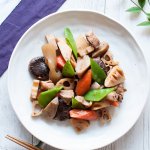
Simmered chicken and vegetables, Chikuzenni, is one of the dishes often served on New Year’s Day. The flavour of chikuzenni is a typical combination of dashi, soy sauce, mirin, sake and sugar but the ingredients are stir-fried first so the dish is much richer than other simmered dishes.
This is my way of making chikuzenni using a standard cooking method.
- 120 g (4.2oz) chicken thigh fillet, cut into 4 cm (1½") cubes
- 100 g (3.5oz) carrot, roll cut into bite size pieces (note 1)
- 100 g (3.5oz) boiled bamboo shoots, cut into bite size pieces (note 2)
- 100 g (3.5oz) burdock, roll cut into bite size pieces (note 1)
- 100 g (3.5oz) lotus root, sliced into 1.5cm (½”) thick (note 3)
- ½ pack of konnyaku (note 4)
- 6 small dried shiitake mushroom, rehydrated, stem removed, preserve shiitake liquid (note 5)
- 60 g (2.1oz) snow peas
- 1 tbsp oil
- 200 ml (6.8oz) dashi stock
- 100 ml (3.4oz) shiitake liquid
- 3 tbsp sake
- 1 tbsp mirin
- 2½ tbsp soy sauce
- 1 tbsp sugar
-
Thinly slice konnyaku into 5mm (3/16") thick pieces. Make 2.5cm (1") incision in the centre of each slice lengthwise. Put one end through the incision and make a twisted konnyaku (note 4).
-
Boil water in a small pot and blanch konnyaku for 30 seconds or so (or pour boiling water over the konnyaku in a sieve). This will set the twists of the konnyaku and prevent the konnyaku from being untwisted. It also removes the unique konnyaku smell.
-
Blanch snow peas in a small pot with a pinch of salt. (note 6)
-
Add the oil in a large pot and heat over medium high heat. Add chicken and cook until the outside of the chicken pieces are cooked.
-
Add carrot, bamboo shoots, burdock, lotus root and konnyaku to the pot. Stir for a few minutes until outside of the vegetables is slightly cooked. Then add shiitake and stir.
-
Add the Flavouring Ingredients to the pot and bring it to a boil. If scum surfaces, remove.
-
Reduce heat to medium, place a drop lid (note 7) and cook for 10 minutes with the lid on.
-
Turn the heat off. Place the chikuzenni into a shallow bowl or a deep plate, scatter the snow peas to decorate.
1. This roll cut is called rangiri (乱切り) in Japanese. Please see my recipe, Sweet and Sour Pork Meatballs regarding how to cut rangiri.
2. I usually quarter (half if thin bamboo) the bamboo shoot vertically, then cut the tip off to 5cm (2") length. Slice the rest 1.5cm (½”) thick.
You can buy a bag of boiled bamboo shoots at Japanese grocery stores. You can also buy boiled bamboo shoots in a can at Asian grocery stores but the canned bamboo shoots I buy in Sydney are a bit stringy while those in a bag from the Japanese grocery stores are tender. So, when I cook bamboo shoots with a light flavour, I use the one from Japanese grocery stores.
3. My lotus root was 7cm (2¾”) in diameter so I cut each slice into quarter. If the lotus root is skinny, you can use it in a round shape. It should be bite size. Fresh lotus roots are seasonal in Sydney.
If you cannot find fresh ones, you can buy frozen lotus roots from Japanese/Asian grocery stores. They are already peeled and sliced into discs which are just right for this dish. If the diameter of the sliced lotus root is very large, cut them into half or quarter.
4. You can buy konnyaku at Japanese/Asian grocery stores. It is sold as a 250g (8.8oz) block in a plastic bag with water in it. You might find a greyish one and blackish one which contains seaweed. Either type of konnyaku is fine.
This twisted konnyaku is called tazuna konnyaku (手綱こんにゃく). See 3rd - 6th photos in the photo panel - Ingredients prepared by Michiko at the very end of this blog.
5. If shiitake is large, cut it into half or quarter.
6. As you will see in Michiko’s Chikuzenni, Japanese snow peas are quite small, about 4cm (1½”) long. But here in Sydney, most snow peas are huge and I only had 7-8cm (3”) long snow peas this time. If your snow peas are large, cut them into half diagonally after boiling.
7. Drop lid is called otoshi buta (落し蓋) in Japanese. It is a round lid which is slightly smaller than the opening of a pot. It is traditionally made of wood but I have a stainless lid. It is placed on top of the ingredients in a pot to ensure the heat is evenly distributed, cook faster, make the ingredients stay in place without breaking apart. It also stops the liquid from evaporating quickly.
If you don’t have a drop lid, you can make one with aluminium foil. Cut a square foil, fold the edges to make it a round shape with the diameter slightly smaller than the pot. Then poke the foil with a knife or a chopstick to make holes in several places.
8. Chikuzenni keeps several days in the fridge. Great for bento box, too.